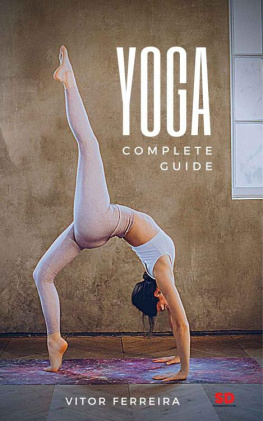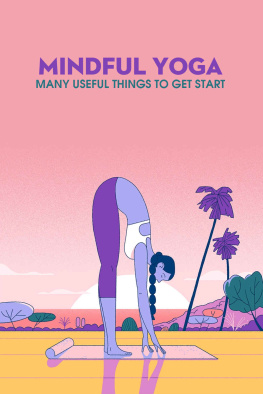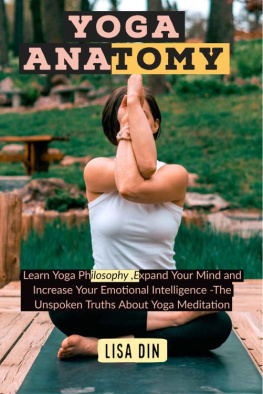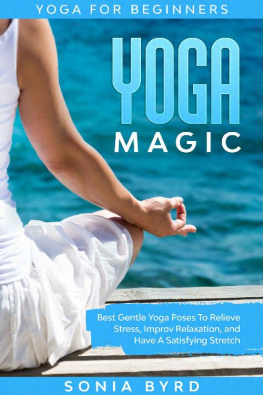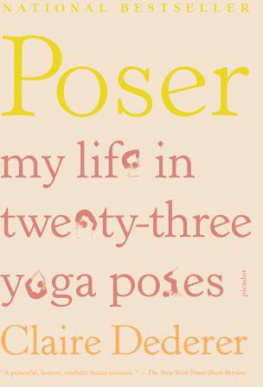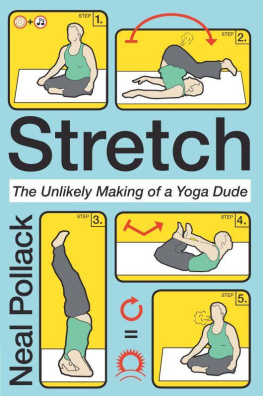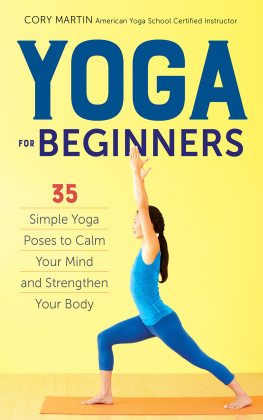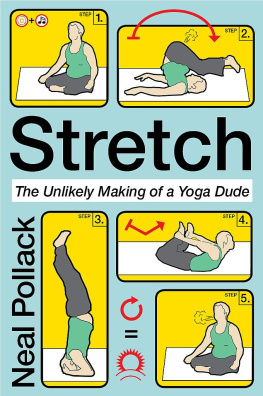

Copyright 2014 by Melissa Carroll.
All rights reserved. Except for brief passages quoted in newspaper, magazine, radio, or television reviews, no part of this book may be reproduced in any form or by any means, electronic or mechanical, including photocopying or recording, or by information storage or retrieval system, without permission in writing from the publisher.
Published in the United States by Viva Editions, an imprint of Cleis Press, Inc.,
2246 Sixth Street, Berkeley, California 94710.
Cover design: Scott Idleman/Blink
Cover photograph: Joshua Hodge Photography/Getty Images
Text design: Frank Wiedemann
First Edition.
10 9 8 7 6 5 4 3 2 1
E-book ISBN: 978-1-936740-98-7
Library of Congress Cataloging-in-Publication Data
Going Om : real-life stories on and off the yoga mat / edited by Melissa Carroll.
pages cm
1. Mind and body. 2. Yoga. I. Carroll, Melissa.
BF161.G56 2014
613.70460922--dc23
2014007101
Welcome OM
W e unroll a mat and, unexpectedly, we fall in love. We fall in love with the way we can feel in these moving, breathing bodies of ours. We fall in love with the sweetness of stillness. As Lisa Knopp says in her tender essay, I hadnt expected to be transformed by yoga. And yet we are. We continue to be transformed, time and time again. This constant shifting, of course, permeates beyond the incense-laced yoga studios, touching all facets of our lives.
Which is probably why if you say you practice yoga in 2014, more than 20 million Americans will nod and grin, having also wiggled through a Sun Salutation. But if you said the word yoga fifty years ago at the workplace or a dinner party, you may as well have just claimed to sacrifice toddlers in the name of Lord Vishnu. Yoga seeped into the United States from India in 1900, but it took nearly the entire century for the practice to carve its way into the countrys cultural and emotional landscape.
And now its popularity is undeniable: from Key West to Prudhoe Bay, yoga studios have cropped up in strip malls and small towns, next to pizzerias and karate dojos. Yoga got trendy, hippie turned hot, Buddha became badass. Yoga pants are the new jeans.
We know yoga has assimilated into the American mainstream, from Power Fusion to Naked Yoga to Doga: Yoga with Your Dog. But what draws millions of Americans to the mat? How has the pulse of our lives pushed us to touch the center of stillness? What exactly are we searching for? And what do we find once we get there?
Going OM is an exploration of these questions, through candid, witty, and courageous literary nonfiction.
When compiling the essays for this book, I wanted to capture the real experiences of regular people on and off the mat. Not rubber bands, not Cirque du Soleil extras, not wisdom-spouting sages. As Neal Pollack opens his essay: When you think of a yogi, my dad isnt what comes to mind, unless youre thinking of Yogi Bear. I didnt ask yoga masters to contribute; I asked writers.
Just as yoga and meditation are paths within, writing is a path to better understand ourselves and the world around us. To write is to translate the world. To be a writer or a yogi, we must be observers. We must quietly witness and patiently absorb all the wonder, seeming confusion, and paradoxical beauty that exists. Both writers and yoga students seek to make meaning of this wildly miraculous human experience.
I was more interested in the stories of people who cant touch their toes, who have known loss, who have felt deeply insecure in the back row of a class, sweating while seeking a little self-love. Some of the finest national bestselling and up-and-coming writers have shared their stories, their insights, and their lives in this book: what emerged has blown me away.
What bubbled up again and again in so many of these essays? Struggle, self-doubt, relationships, the frenetic brain with its to-do lists and what-ifs and Im-not-good-enoughs. How, for most of us mere mortals, our bodies are not the sinewy, Lululemon-clad acrobats posing in yoga magazines. And we are stunning in our imperfections, though that term doesnt feel rightperhaps humanness is more appropriate. We are stunning in our humanness, and in many of these brilliant, touching, hilarious essays, the practice of yogawith its stumbling and flailing and unfoldingreveals our humanness to ourselves.
Claire Dederer so astutely says in her essay, We all have a deep need to be in our bodies, experiencing them with immediacy. Unhindered by the patterning of consciousness.
Throughout Going OM, the body is encountered again and again, in its myriad forms and manifestations. Ira Sukrungruangs deeply moving Body Replies recounts his relationship with his four-hundred-pound diabetic body, his yoga, and his self-image. Emily Rapp pulls back the veil of the self in an Ashtanga classas a woman with an artificial leg who is a former anorexic, she reveals that ultimately what we are seeking is not technical perfection but acceptance and aliveness: to be seen for precisely who we are and to know that, yes, we can be enough.
The writers of Going OM have felt the heft of loss drop them heavier into the earth. They have been made vulnerable because life has broken them open. But there is openness in the breaking places. Those openings offer space for the breath to move. And breath, not surprisingly, is a theme we return to again and again.
In yoga we are taught how to breathe, something weve done our entire lives, and yet something we dont usually do well. With equal parts tenderness and humor, Suzanne Morrison weaves the narrative of her mothers breast cancer with her own struggle gasping for air in her life, and how she learned, through cigarettes, singing, and pranayama, to breathe a little easier. Sonya Huber depicts her similar quest to take a deep breath: as she puts it, My throat chakra is all jacked up. Adriana Pramo tells her gripping narrative of betrayal, redemption, and love, when she locks herself in a British mansion during her stepdaughters elegant wedding and then employs Eastern philosophy to ease a panic attack. Dani Shapiros keen awareness of the all of itthe richness in both the mundane and the meaningfulhelps us recognize the preciousness of the present.
We know yoga is so much richer than just a series of poses, though the physicality of the practice often opens us up to the deeper, metaphoric, and more spiritual elements. With incandescent wit and wisdom, Claire Dederer candidly talks about yogas inherent sexiness (there certainly is a lot of bending over in tight pants), which is really about our inhabiting this body of ours. Jason Tucker links his fathers lifetime labor as a machinist in rural Alabama to yogic insights. Plus, in two essays, dogs are the teachers, helping authors Brenda Miller and Adriana Pramo remember the fullness of the present. (Ive always said dogs were natural yoga masters. We modeled one of the most recognizable postures after them!)
Going OM connects these vibrant, diverse voices to bridge the individual experience of yoga with the collective. The very act of writing is an act of connection, and in this we are reminded that we are not, in fact, alone.
Reading these heart-wrenching and yet often hilarious stories reminded me of my first yoga class in 2006. I was twenty-two and, like so many, wanted to find meaning in my life. And like so many, I searched for it in the external: I was grasping for happiness in objects, in other people, and in my ideas about who I should be. The religion I had grown up with left me questioning, and nights of partying left me unfulfilled. Id wrestled with depression, anxiety, and chronic headaches since I was nine. There was this knot of sadness lodged deep within meit felt at once acute and vagueand I had no idea how it got there. I wanted to feel at ease in my own skin, not tossed by the changing winds of circumstance. I wanted what I think ultimately everyone wants: a little slice of inner peace.
Next page

